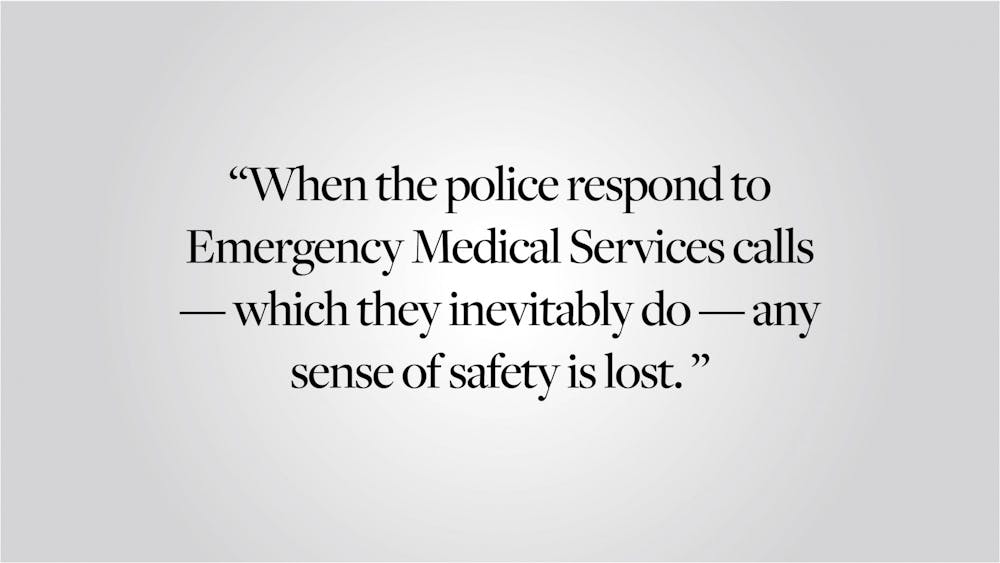Policing at Brown is omnipresent, what with police cars stationed at every street corner and sirens wailing on Thayer Street every Friday night. The Department of Public Safety’s website even makes it clear: “We are a full-service public safety department,” it claims, “that serves the Brown Community 24 hours a day, 7 days a week.” This constant surveillance is presented as a promise of safety and community. However, when the police respond to Brown Emergency Medical Services calls — which they inevitably do — any sense of safety is lost.
Since EMS is advertised to students as the response service to medical emergencies, as a first-year, I had no idea that EMS works “closely” with DPS — to the extent that police officers directly respond to EMS calls alongside, or even instead of, medical professionals — until very recently. Unfortunately, I learned this lesson in a tense situation. A person I was with got a little too drunk, and I and the other students present felt there was nothing to do except call EMS for medical help. Instead of a medical professional, an armed police officer showed up to the door and began asking the person questions, even when the person was visibly uncomfortable, scared and could barely form words. In the end, the police officer never offered medical support and medical professionals never showed up. After half an hour, the police officer brought the person who needed help to the hospital.
Because of the unclear connection between the two departments, no student that I was with was aware that calling EMS would lead to the police showing up. Furthermore, there was no practical reason for the police to show up — the officer did nothing an EMS responder couldn’t have done, except elicit fear. In the United States in general, the relationship that campus police have with the student bodies they purport to serve is contentious. At Brown last year, more than 40% of polled students reported that they would be uncomfortable with DPS enforcing social distancing. For those who opposed DPS enforcement, their reasoning was largely related to their issues with the department — for instance, that DPS wasn’t trained or suited to respond to this issue, and that DPS carried weapons. Considering this tension, sending police to respond to medical emergencies adds fear to a situation already rife with it. This reality is particularly true for students of color, given the United States’ history of racialized police brutality. In the context of many students’ relationship to DPS, surprising students with a police officer when they expect an EMT is at best tone-deaf and at worst traumatic.
In response to the question of why police officers “accompany” EMS to medical emergency calls, the EMS website claims that the police are needed to provide access to the building and protect EMS officials. There is an easy solution to the former issue: Give EMS officials access to campus buildings. Concerning the latter, EMS should assess calls prior to dispatch and determine whether protection — especially armed protection — is necessary, rather than sending police for any and all EMS calls. Even in cases in which protection is needed, police officers may not be fully equipped to de-escalate a potential belligerent response to EMS. Instead, Brown should invest in behavioral health crisis response services consisting of individuals who are specifically trained to deal with substance abuse emergencies and are separate from law enforcement. This method would prioritize appropriately responding to the compromised individual in order to de-escalate the situation. As opposed to the supposed protection that weaponized police might bring, a community-based approach would allow trained professionals, who understand how to best keep themselves and others safe when dealing with potentially dangerous or aggressive responses, to accompany EMS personnel. While the presence of an officer could create tension and dissuade students from calling EMS, this police-free alternative would offer necessary protection without needlessly worrying or aggravating students.
Furthermore, in my situation, an EMS respondent never even showed up to help the intoxicated person — only the police. Clearly, EMS and DPS are so interconnected that it was considered appropriate to completely replace EMS with the police. This close relationship between the two agencies needs to end — students should not have to feel like they are putting themselves and others in danger by calling for help for a friend.
This campus has a long way to go in confronting its close relationship with a weaponized policing system that frightens and surveils students. This change starts with ending the entanglement between EMS and DPS. If Brown wants to ensure that its students feel safe on campus, they should stop sending police officers in response to all EMS calls.





